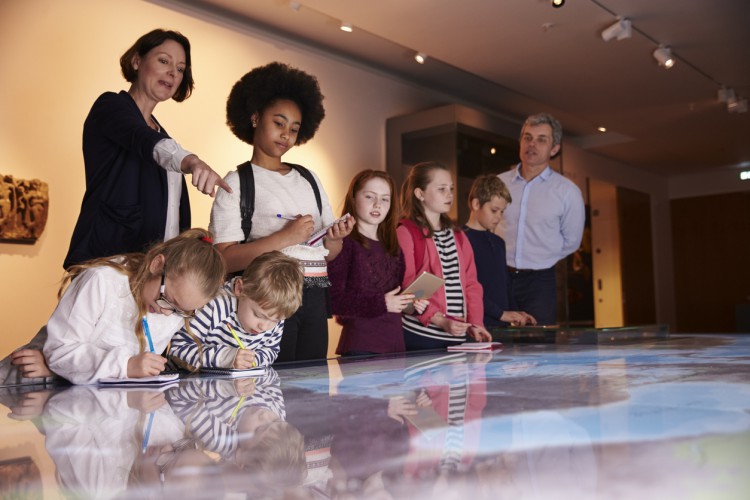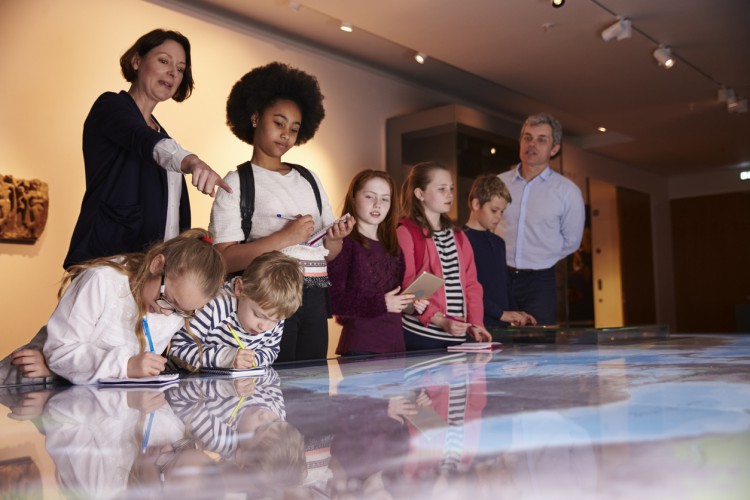Curator vs. Museum Educator: What’s the Difference?

Museums procure, study, and display art and other objects of lasting interest. For instance, the National Portrait Gallery in Washington, D.C., showcases paintings of former American presidents, while the Smithsonian National Museum of Natural History delves into Earth’s history, exhibiting ancient fossils and life-sized animal replicas. Museums offer engaging ways to learn about history, science, art, and more. An estimated 14 million Americans visit museums every year, many of them children. Children in particular can benefit from museum visits, which give them a chance to explore and connect with new subjects in person rather than through a screen.

It’s clear that museums don’t just serve to display objects, they also aim to spread knowledge. By exposing visitors to new concepts and ideas, they encourage curiosity and open-mindedness. Museums play a valuable role in society. To operate, they need a variety of workers to support their day-to-day operations, including curators and museum educators. Both positions are integral to a museum’s success, but the job duties of each are distinct. This article looks at curators vs. museum educators, and reveals how a Bachelor of Arts in History can pave the path for individuals interested in either.
What Does a Museum Curator Do?
A museum curator manages the pieces of a museum. Museums usually house permanent collections as well as revolving temporary exhibitions that often consist of items borrowed from other institutions. The curator is the administrator in charge of deciding what objects should be acquired for permanent display as well as establishing contracts and making arrangements with traveling exhibits for temporary displays. They also determine how pieces should be arranged within the museum, addressing everything from layout to the aesthetic appearance of a given exhibit.
A curator does not just work behind the scenes, however, but also serves as the “face” of the museum. Curators may give quotes for press releases announcing new acquisitions, for example, or participate in interviews, press conferences, or panel discussions about topics relevant to the museum’s exhibitions and special events. In any of these instances, curators must be able to answer questions about the pieces on display.
To perform their duties, museum curators need the following skills:
- Research skills: Curators must have expansive knowledge of their museum’s subject matter. This allows them to identify interesting, relevant artifacts for the organization’s collections. Developing this knowledge base requires extensive research. This knowledge must also be updated regularly. New findings in history and art occur all the time, and it is important that curators stay abreast of research developments and new discoveries.
- Creativity: Curators must also have the creative talents to envision and execute the setup and design of exhibitions. Having a good eye for interior design is helpful. They should also be aware of how people move through an exhibit space, coming up with creative ways to draw attention to especially noteworthy objects. For instance, if an important new painting arrives, it should be displayed prominently where it will gain maximum exposure.
- People skills: Thanks to the public-facing nature of the role, curators must also have excellent people skills. According to a report in The Guardian, a curator’s job largely involves talking with the public. They not only represent the museum at press functions, they also circulate at fundraising events. Here, they are required to engage with patrons and potential donors, serving as a font of knowledge for interested individuals.
Those interested in museum curating will find a challenging, exciting future as museums evolve in how they connect with their visitors. Technologies such as virtual reality are offering innovative ways for museum guests to interact with exhibits, for instance. The U.S. Bureau of Labor Statistics reports that the museum industry is expected to grow at a faster-than-average rate of 9% from 2018 to 2028. According to PayScale data from September 2019, the median museum curator salary is around $49,000 per year.
What Does a Museum Educator Do?
Like curators, museum educators are responsible for sharing knowledge about a museum’s exhibitions and objects. But while curators tend to take on this education role informally, for instance as part of a press conference or fundraiser, museum educators are singularly devoted to teaching. These professionals tend to work in classroom-like settings and give frequent presentations on artifacts, providing museum visitors with details such as historical context.
These presentations are often given to children, usually visiting school classes. Museum educators must thus be adept at speaking to and working with young people. Their work may also include outreach activities, such as visiting area schools to share news about a museum and its exhibits.
To perform their duties, museum educators need these skills:
- Public speaking: Museum curators must be comfortable speaking in front of large groups. They must be able to speak clearly, naturally, and with confidence. Since they are often talking to children, who have shorter attention spans than adults, it is important that they be able to speak in an engaging manner, for instance, by inviting active participation.
- Writing: Museum curators must be adept with the written as well as the spoken word. Part of the job involves creating interesting curricula for the educational programs and presentations they give. The lesson plans they write need to stimulate and captivate the audiences they teach, and the other materials need to be easy for visitors to understand.
- Research: Like curators, museum educators must also be skilled researchers. This enables them to acquire the knowledge they can then pass on to their students. Only once they have a thorough and detailed grasp of their subject matter can they pass along important information to inquisitive visitors.
Some might argue that advances in digital technology will negate the need for museum educators. According to The Journal of Museum Education, however, these professionals are more important than ever — for instance, in efforts to improve diversity and ensure inclusion across class and social lines in museum spaces. The previously mentioned BLS projection of faster-than-average growth (9%) for museum workers from 2018 to 2028 also holds true for museum educators. According to PayScale data from September 2019, the median museum educator salary is around $35,500 per year.
How a Bachelor of Arts in History Prepares You for a Career in Museums
Those who want to pursue a career as either a curator or an educator in a museum can benefit from a history degree. Maryville University’s online Bachelor of Arts in History prepares students for jobs in the museum field by teaching them how to research, write, and speak professionally. Relevant coursework includes classes such as Historical Methods & Digital Humanities and a history portfolio project. Explore your potential with Maryville University, and take the first step toward a museum career.
Recommended Reading
Digital Technology and Schools of the Future
Teachable Moments: What’s in Store for the Future Educators of America?
Sources
Artnet, “Art Demystified: What Do Curators Actually Do?”
Bureau of Labor Statistics, Occupational Outlook Handbook, Archivists, Curators, and Museum Workers
National Endowment for the Arts, “The Importance of Taking Children to Museums”
Oxford Bibliographies, Museums, Education, and Curriculum
PayScale, Average Curator, Museum Salary

